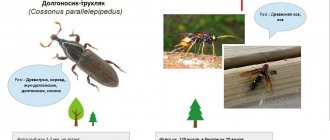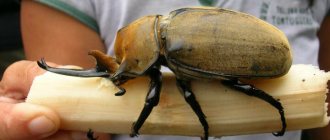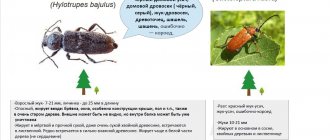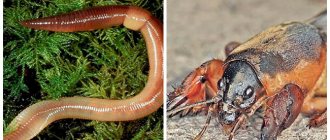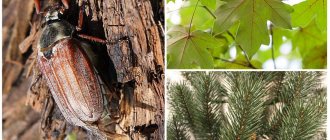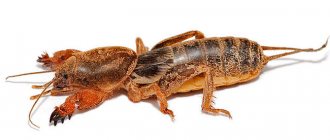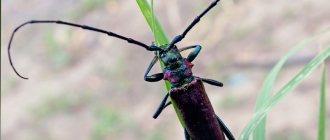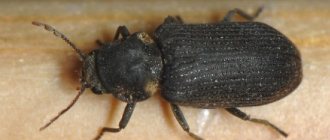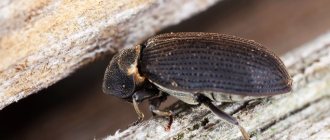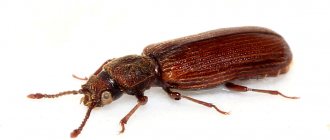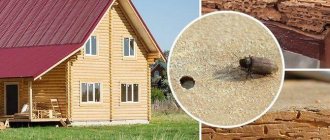Methods to combat bugs
If black beetles appear in the apartment, then first you should determine their type based on external signs.
Depending on the identification, you can use various control methods to help get rid of black beetles:
- Carpet beetles and carpet pests should be combated by treating carpets and furniture; first they must be wiped with a sponge soaked in a soap solution, and then with a vinegar solution; a day after treatment, carpets and furniture should be vacuumed well, and the contents of the bag should be thrown away, as there may be insect eggs in there;
- to destroy flour beetles, it is necessary to carefully sort through all reserves of bulk products (flour, cereals, sugar, etc.); if they are found, everything must be thrown away, because they are not suitable for consumption;
- inspect the contents of all cabinets for small black or red bugs, then make a solution of 1 tbsp. l. soda per 1 liter of water and treat all surfaces and shelves inside the cabinets, wash the dishes using detergents and pour boiling water over them;
- wash all surfaces in the kitchen with a solution of acetic acid or use boric acid powder, which should be rubbed into areas where parasites may live;
- treat the floor covering and baseboards with any aerosol containing an insecticide against insects (Dichlorvos, Combat, Raid, etc.);
- clothes should be boiled or washed in hot water (not lower than 60°C).
If the measures taken do not help or there is no time to fight bugs in the apartment for a long time, then it is better to turn to professionals. There are companies that use special preparations to carry out disinfestation (extermination of pests) in any residential premises.
Fighting bugs in the house
Pest danger to humans
Are there cockroaches, mice or other pests in your dacha or apartment?
We need to fight them! They are carriers of serious diseases: salmonellosis, rabies. Many summer residents are faced with pests that destroy crops and damage plants.
The troubles associated with the proximity of a small brown bug for a person are associated with the manifestation of the following negative consequences:
- consequences of a painful bite especially for children and women;
- manifestation of an allergic reaction in people prone to this disease;
- transfer of pathogenic viruses, for example infection by helminths (due to larvae feeding on the remains of plant and animal food);
- deterioration of expensive and beloved things.
Despite its small size, the bite of a brown bug is quite painful. Each person has their own reaction to such bites. It can cause redness and subsequent inflammation at the bite site. During a bite, pathogenic bacteria can enter the wound and cause infection not only of the bite site, but of the entire body.
Let's celebrate! Untimely treatment can cause an inflammatory process, which only a professional physician can help cope with and self-medication will not help.
If small brown beetles with wings appear in your apartment, then you need to look for where the larvae breed. One skin beetle that accidentally flew into an apartment may be a “guest”, several may already be tenants. To get rid of small bugs in the apartment, you will have to shake out all the contents of the kitchen and wardrobes. And at the same time take a closer look at the furniture. Some leather beetles do not disdain synthetics.
Spoiled cereals are thrown away. In the future, it should be stored in glass or metal closed containers. Review all clothing and carefully check crevices behind baseboards and ventilation openings. Carefully inspect carpets, especially those rolled into rolls.
After the main nest is discovered, spoiled items and food are thrown away. The entire apartment is thoroughly vacuumed. Immediately after cleaning, the dust bag is shaken out outside the apartment. It's good if you can burn the insects.
For preventive purposes, it is recommended to periodically ventilate and freeze household items.
For a furniture grinder, the methods of control are different: manually processing the holes made by the larvae - these are holes 1-2 mm in size and you need to carefully inspect the wooden parts of the furniture to detect the larvae. Vaseline oil is pumped into the discovered holes from a syringe with a needle and the mink is caulked with wax, paraffin or window putty.
White insects in the apartment - who are they?
While recognizing cockroaches and ants is not difficult, the appearance of strange little bugs causes serious difficulties, since in order to eliminate parasites, one must know their exact type.
Let's try to figure out who can start up in the house.
- The most common type of parasitic white insects in an apartment is silverfish (in common parlance - woodlice). It is a small wingless individual, an oblong body with numerous legs. In fact, the body of the parasite is not completely white, it is rather silver, but in sunlight it appears almost transparent. Such insects feed on starch and products containing it. Due to the fact that silverfish choose damp places, the main area where the insects will be located will be the bathroom or kitchen, especially the sink area.
- The sugar silverfish can be designated as a separate species; it most often appears in food warehouses, kitchen drawers with food, and libraries (since it loves book bindings and glued pages). Such insects come out only in the dark, so it is quite difficult to detect them.
- White midges most often appear on indoor plants; this insect is called a whitefly. It is almost impossible to prevent its occurrence, but it is very easy to escape from it - just treat the soil and affected leaves with a weak solution of manganese, repeating the procedure if necessary.
- Light-colored bugs in kitchen cabinets can be food midges; they feed on cereals and other bulk products, spread very quickly, and in a few days the pest population can increase several times. These insects can appear in an apartment due to improper sanitary conditions - high levels of humidity, the presence of crumbs and other debris. Having appeared in one product, after a couple of hours the midges will move to other places, and they actively infect even hermetically sealed products.
Of course, there are other representatives of parasitic insects that can occur in an apartment; each species has its own means of control, but if you cannot determine the exact type of pest, use complex preparations that help get rid of any apartment parasites.
Why do they appear?
These bugs can be seen everywhere:
- Under the baseboards.
- In places where bulk products are stored.
- In closets with clothes.
- Behind the radiators of the heating system.
- In carpets and runners.
- On indoor ornamental plants.
- Inside various furniture.
- Close to heating appliances.
- On the windowsills.
- In places where smoked and dried products, including meat, are stored.
- In areas where grains or peanuts are stored.
- Among the waste paper.
The larvae of carpet beetles are quite tenacious compared to adult beetles. They can live without food for several weeks. In places where it is dry, including behind baseboards, in corners, and also near the back wall of a furniture cabinet, all conditions for normal life have been created for them. Sunlight does not penetrate into such places, which creates comfortable conditions for these insects.
How do insects enter a person’s home?
There are many ways for such insects to enter an apartment or house. For example:
- Through open doors, windows and vents, if they are not protected by anything.
- With purchased or donated old books or furniture.
- With used items, if they were purchased secondhand.
- Inside the products if they were not stored correctly.
- With grains or cereals.
- With dried foods bought at the supermarket.
- From attics and basements, unless special services are watching them.
- With dried mushrooms or dried fruits, as well as medicinal herbs purchased at the market.
- With old carpets, also bought secondhand.
It is quite difficult to somehow prevent the appearance of these pests due to their small size. Since they are difficult to notice even upon inspection, since their brown color allows them to camouflage, they easily penetrate into a person’s home.
Methods for getting rid of black bugs in the kitchen
If you find bugs in the kitchen, take the necessary measures to destroy them:
- Identify and correct the source of the problem. Empty the cabinets and review all supplies of cereals, flour, dried fruits, tablets, tea and coffee. Place spoiled food in a bag and place it in the trash.
- Inspect the kitchen furniture, window sill and household appliances - sometimes uninvited guests are found in such unusual places.
- Wash food storage containers with soda solution.
- Wipe the doors and shelves of cabinets in the kitchen with a cloth soaked in a solution of vinegar (1 tablespoon per 1 liter of water) or detergent.
- Seal or seal any cracks that are discovered during cleaning.
- Pack the remaining intact cereals in an airtight glass container and take them outside the kitchen for 10-14 days. If no insects appear in them during this time, they can be eaten.
Products that could be contaminated with parasites are subject to special treatment. The following methods are used for this purpose:
- exposure to ultraviolet radiation;
- exposure at high temperatures in the oven (10 minutes at a temperature of +100…120 ℃);
- exposure to low temperatures during the day (in the freezer).
Folk ways to fight bugs
To combat bugs in the kitchen, products with a bright aroma are used. Pests are repelled by the smell of bay leaves, lavender, garlic, wormwood, borax, vinegar and nutmeg. To get rid of pests, place any of them on the shelves of the closet and do not forget to change them periodically.
Traps that you can make at home will help you get rid of pests:
- Combine borax and powdered sugar in equal proportions.
- Pour the mixture into the lid and place the trap near the pest habitat.
- Check the bait regularly and refill it if necessary.
Chemicals in pest control
When folk remedies do not help cope with pests, perform chemical treatment of the room. The method is used in exceptional cases with large-scale damage.
Treating cabinets with chlorine-containing products (Domestos, Belizna, etc.) will help you deal with bugs in the kitchen. Wipe all shelves, walls, cabinet doors and leave the room to ventilate for a couple of hours. After a day, repeat the treatment.
Other means to combat bugs in cereals and in the kitchen:
pyrethrum powder. Sprinkle the product where you store food and after a couple of days you will forget about pests. The insecticide is safe for pets and people; "Lovin Fire Protection". An effective poison for flour eaters and bread grinders. When using the product, wear a respirator, as its fumes are dangerous to humans; "Anti-bug." Treat wooden surfaces with a special protective agent - it will not only get rid of pests, but also prevent their appearance in the future
Be careful when working with the product, as it is dangerous if it comes into contact with the skin or mucous membranes; "Rogneda". The drugs of this brand are effective in combating various pests - bugs, ants, flies, fruit flies, cockroaches. According to consumer reviews, proven Dichlorvos will help remove bugs forever
Procedure for using the aerosol:
According to consumer reviews, proven Dichlorvos will help remove bugs forever. Procedure for using the aerosol:
- Hide all food products and throw away spoiled products.
- Wash cereal containers and all kitchen cabinets.
- Make sure there are no pets or children in the room. Take personal safety measures - wear a respirator or bandage.
- Spray the room with an aerosol and close the kitchen for half an hour. Then turn on the hood and open the window to ventilate the apartment well.
Home thermobia
In living spaces, unpleasant-looking insects called silverfish often appear and settle for a long period of time. The bugs have no wings. An oblong body with a small head with antennae and three tails in the form of processes causes outright hostility among people. They get stuck in the darkened holes in the corners. Home thermobia settles in the bathrooms of apartments and country houses, causing damage to objects and coatings.
Small insects are not uncommon in the apartment. And it's not just fleas and cockroaches
But, taking certain precautions and following the clear instructions in the instructions when fighting all kinds of bugs, it is possible to achieve the desired effect, and no worms will appear in the apartment. Remember that only the owner will cope with the problem who treats the problem with full responsibility
What do kravchiki look like?
Body size varies from 2 to 3.5 cm. Males are larger than females. A characteristic feature is a large head with large jaws. Males have additional fangs. Males use them when fighting with an enemy or competitor during the mating season.
The large head smoothly blends into the chest. The abdomen is convex, making up 1/3 of the whole body. There are no wings, snow beetles live underground and crawl on the surface. The body is covered with a durable chitinous covering. The color is coal black or with a blue tint. The legs are short, strong, ending in claws. A photo of the imago is presented below.
Mucoeds
They are polyphagous beetles, that is, their menu is very diverse. Three types can be found in apartments.
Surinamese
A beetle 3-3.5 mm long with a red-brown back. The pest is flat, very elongated in length, with a thin body. The pronotum has characteristic longitudinal “ribs”.
Prefers bakeries as a bottomless source of nutrition. But often, along with flour and cereals, it gets into apartments, where it infects other supplies. The vital activity of bugs leads to an increase in humidity in products, which is why mold forms in cereals.
Maximum lifespan 3 years. Usual 6-10 months. The life cycle is 27-51 days at a temperature of 29-35°C.
During her life, the female lays 43-285 eggs. At an ideal temperature of 27-29°C, the larvae hatch after 3-5 days. The larva grows up to 3 mm, has a yellow-white color and a brown head.
Red mukoed
The light brown beetle is approximately 2 times smaller than its Surinamese “brother”. In the apartment, the food supply, habitats and life cycle are similar to those of the Suriname mucoedeater. A distinctive feature of the red mucous eater is inactivity.
Mucoeds
Merchant beetle
A flat small beetle, 2.5 cm long. Almost completely identical to the Surinamese beetle in morphology and lifestyle, differing in eye size and head shape. The bugs crawl actively, moving to new habitats.
White bugs
Small white insects in the apartment can also bother residents. They appear in the house due to dampness and lack of proper cleanliness. It is possible for them to enter the home through unclosed doorways or windows, holes in risers and walls.
It is not difficult to recognize ants or cockroaches, which is impossible to say about small bugs of unknown origin. To get rid of parasitic individuals, you need to know what they look like.
The most famous insect that lives in apartments is the silverfish, or woodlice. The wingless variety with an oblong body has numerous legs. The silvery surface of the bug appears transparent in sunlight. The food for this is starch and products containing it. Due to its damp habitation, it is not difficult to find in bathrooms or kitchen sink areas.
Because they live on book bindings and glued pages, they are called “book louse.” The sugar variety of pests is found in food boxes, food storage warehouses, and libraries. They are difficult to notice because they appear on the surface after dark.
Whiteflies live on indoor plants. Rescue from the bug is caused by treating the affected leaves and soil with a weak solution of manganese. White bugs in pieces of furniture in the kitchen are food midges that eat bulk foods. They are characterized by rapid reproduction. The cause is premises without proper sanitary treatment. Such an area is an ideal habitat for them.
Their settlement is facilitated by excessive humidity, uncollected crumbs and other debris. Insects can infest one type of product and easily move to neighboring food, vigorously attacking hermetically sealed objects.
To combat this, agents and chemicals that do not pose a risk to human health are effective. Comprehensive pest control leads to the desired result. It is necessary to free the room from traces of cobwebs, dust and all kinds of contaminants, followed by disinfection with chlorine-containing substances from a series of household preparations.
After the surfaces have dried, hidden holes and corners are wiped with copper sulfate. Heat fans or hair dryers are most effective. At the final stage, the rooms are cleaned with the addition of vinegar water. Magazines and books are checked for insect eggs being laid in them. The shelves should be sprayed with water with the addition of lemon or intensively blown with a vacuum cleaner.
Photos and names of black beetles
You can determine exactly what the black beetle in the house is called by its appearance and size, as well as its location.
They can settle both in food and in furniture, carpets or wooden structures and walls. In total, there are 3 types of Khrushchak:
- large beetles - differ in their length (up to 13 mm);
- small – have a size of up to 3.6 mm;
- black - distinguished by black color.
Black bugs in the apartment In addition to the flour beetle, there are other types of small black bugs in the apartment:
- skin beetles - small black insects up to 4 mm in size that feed on fur and leather products, paper from books, indoor plants and food (flour, nuts, cereals, meat, etc.) - live in closets, old clothes, crevices of furniture; dangerous because they can carry infections and helminths;
- carpet beetles - they settle in beds and carpets, feeding on old peeling human skin, hair and crumbs; they can render things unusable and also cause allergies in some people;
- fleas are small jumping parasites that bite painfully and can carry infection; they often appear in homes where cats and dogs live.
Appearance Features
The order of arachnids received its name because of its unusual pedipalps, which end in claws, like those of a scorpion or crayfish. In total, 3,300 species of pseudoscorpions are known. They live in tropical countries and continents with cold climates. They live in caves, high in the mountains, and holes in the ground. There is only one species found in a person’s home – Chelifer cancroides. Found in books and dusty rooms.
- The book false scorpion looks like a house tick. The body is flattened, miniature, with a dense chitinous cover. The adult size is 3 mm.
- In front is a small cephalothorax with two claws - modified pedipalps. The beetle, similar to a crayfish, uses its “weapon” to capture prey, grind it, and crush the integument. The length of the claws is equal to half the small body of the beetle.
- Colors in brown tones - dark, light. Sometimes the beetle is perceived as black. The abdomen has even stripes.
- 4 pairs of legs are attached to the cephalothorax. Short but strong. They end in claws. The pseudoscorpion moves slowly, often sideways, but can walk forward and backward.
A photo of an insect similar to a scorpion is located below. Females are slightly larger than males. The larvae are initially born white, then the chitinous cover darkens, and after the first molt it becomes denser.
Preventive measures
If the home is old, then it needs to be renovated a little. The main tasks in this case: filling gaps in the frame of the house, window frames, door frames, ceilings, walls.
It is important to block access to the housing area through ventilation ducts. A fine-mesh mesh is installed here. Mosquito nets are attached to the windows.
If items are sent for long-term storage, they must be placed in pre-treated cabinets. The fur coat is contained in a bag; before this, an insecticide is also sprayed over it. Before using these clothes, they are washed. In the kitchen, you need to regularly clean cabinets and check supplies. It is better to process all bulk products that are brought from the store using the freezing method.
Related posts:
Types of skin beetles and their description
Carpet beetles are small bugs; individuals with a body length of up to 5 mm and a width of about 0.5-1 mm are more common. They have an oval shape, less often they are found with a round or elongated body. There are many types of such insects.
The most common are:
- Ham skin beetle. Found throughout the Eurasian continent. It can appear at home, that is, in residential premises, and in warehouses. These are oblong black bugs. There are gray spots on the upper part of the wings, but it is quite difficult to distinguish them with the naked eye. The larvae of this insect are dangerous. Before pupation, they bite into surrounding materials, and this can be textiles, wood, books and even telephone cables.
- Carpet beetles are a name that combines several types of dark brown carpet beetles. Larvae are also dangerous here. Very often they damage products made of fur and wool, although theoretically they can even feed on particles of house dust that contain organic debris - the same hairs from the carpet. Moreover, only the larvae feed, and adult beetles only constantly consume the nutritional reserves accumulated in the previous period. These are flying bugs. They are found not only in apartments, but also in wildlife, and in natural conditions they settle in tree hollows and bird nests.
- The Smirnov's carpet beetle is a relatively recently introduced species of insect in Russia. It is believed that it was introduced into the country about 50 years ago. During this time, he managed to adapt to local conditions. This is the type that can most often be found on the windowsill.
- The fur coat beetle is a black beetle, but it has small white spots on its back - usually five of them. It is not found so often in apartments, so it is considered relatively harmless. But when these pests get into the house, they do not spoil fur products, but eat various products, especially Hercules flakes.
- Museum and house leather beetles are precisely those insects that are quite rare. Although their eggs can be brought into the house with decorative flowers in pots, which are an ideal habitat for them.
- Frisch's carpet beetle is an oval beetle of dark gray or black color. It is found very rarely in homes.
In Russia, domestic species of insects such as the carpet beetle and Smirnov's carpet beetle are more common.
Thus, these insects can feed on skin, fur, wool, meat products and cereals. In the kitchen they eat cheese, powdered milk and even dried and smoked fish. They can also spoil various grain products and ancient books.
What are the types of such beetles?
Before you begin work on exterminating this insect, you need to clearly know what type of beetles appeared. This will help you get rid of it most effectively.
Perhaps a grinder appeared. This is a beetle that feeds exclusively on wood products. His favorite is old furniture. It can also feed on old books; over a certain period of time, it grinds the pages to a flour-like state and lays eggs there. After that, this is the habitat of the larvae of the borer. And they are precisely omnivores.
The flour beetle is also not the rarest guest in the kitchen. It mainly occurs in flour and cereals. The size of such a beetle can reach only 2-4 mm. The color range varies from dark yellow to brown. Mucoeds are much smaller in size and are not picky about food. In addition to flour and cereals, they also feed on wooden furniture and books.
In addition to these two types of beetles, carpet beetles can also appear. This variety is not distinguished by its harmlessness. It can really harm both the entire house and human health. The carpet beetle is known in various forms, but not everyone can get along in an apartment. The main inhabitants of the apartments are the following:
- ham. The body is black, the antennae are yellow. Oblong in shape. The most common type;
- carpet The larvae of this insect are mainly dangerous. The beetles are brown in color. Feeds mainly on dust. Adult beetles do not feed at all, as they have a huge supply of nutrients;
- The fur coat beetle is the most harmful beetle compared to the rest. The color is black spotted. Uses food as food;
- Kozheed Smirnova. The diameter of the beetle reaches 3 mm. Coloring page brown. Lives mainly on lamps and window sills.
Such an insect can appear at any time of the year. The place for them to enter a living space can be either an open window or ventilation holes. Some species disappear with cold weather, while others, on the contrary, live throughout the year.
First of all, you need to look for bugs in open bags of cereals. It is thanks to the open space that it is easiest for beetles to climb. If there are a lot of beetles in such a bag, then you need to take active action, because they have already penetrated into closed containers with cereals. The hole that such a beetle gnaws is very small and is not visible to the human eye.
It is necessary to inspect the entire food supply; beetles can infest not only cereals, but also sugar, pasta, and flour.
There will be no such insects in salt; they have a negative attitude towards it.
The ideal location for beetles is beans. This is a favorite delicacy of such pests. Beans are best stored in the freezer. If this is not possible, then even a closed bag and container will still get a beetle.
It is not uncommon for beans to harbor a special type of beetle. Do not forget that the larvae of such beetles have been in beans before, they just remain dormant for a long time. As soon as the beans are transferred to a warm room, the larvae turn into full-fledged beetles, after which holes and spots appear on the beans. Therefore, to prevent pests, beans must be kept in the freezer.
Attention should also be paid to medicines and spices. Beetles love mustard plasters very much, even despite their bitter taste.
Therefore, it is also necessary to check the mustard plasters. The packaging with patches and tablets also deserves special attention. You need to thoroughly check the entire medicine cabinet. It happens that if you put things in order, the beetles themselves crawl out into a visible place. Spices and seasonings can also harbor pests.
Coffee, dried fruits, and tea also do not go unnoticed by beetles. Housewives constantly forget about these products. And if a brown beetle gets into a coffee can, it will be very difficult to find them. If you make a drink, then such beetles will emerge. And the sight is very creepy. Therefore, it is simply necessary to monitor such containers.
Signs of defeat
Wood-boring beetles reproduce very quickly. These pests begin to destroy wood at an early age
Therefore, it is very important to promptly notice signs of their presence on the site.
Presence of holes on wooden surfaces. The beetles that live in the house always make small holes or full-fledged passages in the tree. Wood flour often pours out of them. Small larvae can also hide in these passages.
Light weight of building materials
When buying boards for finishing a house or bath, you should pay attention to their weight. If the tree seems too light, this may also be a sign of woodworm damage.
They usually eat the board from the inside.
Unpleasant sound. If there is a beetle in the house, you can recognize it by its characteristic grinding sound. It is heard especially well at night.
Presence of dark spots on the surface. In some cases, brown liquid may ooze from the holes made by woodworms. It has a pungent odor and spoils the appearance of the furniture.
In the evening, these pests can be seen with the naked eye. The easiest time to spot them is during mating season. That's when they leave their shelters. Pests crawl on countertops, window sills, and also fly near lamps. Having noticed such bugs, you need to immediately begin pest control.
Description
Latin name: Troctes divinatorius
Other names:
- Book hay beetle
- Dusty (house) hay beetle
Biological group:
- Household insects and mites.
- Pests of grain and stocks.
- Pests of botanical and entomological (insect) collections.
Appearance:
- A small insect (up to 1 mm) whitish or light brown in color.
- The body is flattened, wingless. Towards the end it expands slightly, acquiring a triangular shape.
- They have sharp teeth, compound eyes and long antennae on their heads.
- The pest is characterized by high mobility, endurance and vitality.
Important. The easiest way to distinguish the hay beetle from other similar domestic parasites is by the presence of long, segmented antennae on the head. Peculiarities of reproduction:
- The book louse reproduces without fertilization. Even one of its eggs is enough for the appearance of a whole colony of these pests.
- The female lays up to hundreds of eggs. Under favorable conditions, one generation develops in 3-4 weeks. Up to 6 generations may appear within a year.
- Each larva goes through 6 stages of development. The most optimal conditions for its development are high humidity and temperature +16–35°C.
Preventative measures for brown bugs
To eliminate brown bugs, it is necessary to carry out extermination and preventive measures.
Such activities are expected to include:
- Carrying out periodic checks for the presence of brown bugs;
- Constant ventilation, especially in winter, with the temperature in the room dropping to 12 degrees;
- Sealing of residential premises, eliminating cracks and possible entry points for pests;
- periodic wet cleaning of premises using special products.
Good to know! Controlling such pests is quite difficult. This is due to their small size, high vitality and omnivorous nature. However, the use of preventive measures, periodic inspection of possible places where pests accumulate and carrying out all methods of destruction will prevent the settlement and spread of small brown bugs.
Tired of fighting pests?
Are there cockroaches, mice or other pests in your dacha or apartment? We need to fight them! They are carriers of serious diseases: salmonellosis, rabies.
Many summer residents are faced with pests that destroy crops and damage plants.
The troubles associated with the proximity of a small brown bug for a person are associated with the manifestation of the following negative consequences:
- consequences of a painful bite especially for children and women;
- manifestation of an allergic reaction in people prone to this disease;
- transfer of pathogenic viruses, for example infection by helminths (due to larvae feeding on the remains of plant and animal food);
- deterioration of expensive and beloved things.
Therefore, doctors strongly recommend treating with a disinfectant after detection. This could be hydrogen peroxide, iodine or brilliant green.
Let's celebrate! Untimely treatment can cause an inflammatory process, which only a professional physician can help cope with and self-medication will not help.
How do you get into the apartment?
There are many ways that insects use to get into a person’s home. So you don’t have to wonder where bugs come from in your apartment.
- Housewives bring them from the store along with groceries.
- Bugs that get into the house can be spread by birds. In particular, pigeons. If you feed these birds on the balcony, you can get such an unpleasant living surprise as “gratitude”.
- In high-rise buildings, pests often crawl out of ventilation shafts and cracks near pipelines. This happens if insects have bred in large numbers with neighbors, in the basement or attic.
- From the entrance through the front door, if there is even the slightest crack where this miniature creature can slip through.
- The black flying beetle can take advantage of open windows or a vent if there is no mosquito net.
- Having visited where these insects live, there is a risk of bringing them home on clothes, in hair, or in a bag.
- In summer, they often cling to the fur of animals walking on lawns.
Preventing the appearance of uninvited guests in the house
Following these recommendations will help prevent this problem:
- When it gets warmer, install mosquito nets on the windows;
- Furniture and clothing should be carefully inspected and treated with insecticides after purchase;
- observe a 7-day quarantine for new plants;
- when purchasing cereals, flour and dried fruits, make sure that they are not infested with pests;
- exclude contact of the pet with street shoes and door mats, as well as stray animals while walking;
- if your four-legged pet is outdoors, use anti-flea preventatives;
- Clean the house regularly.
Those most at risk are corner apartments, where the humidity is always higher, apartments on the lower floors, especially if the house has basements, and apartments on the upper floors - next to the roof. Gradually, insects can spread throughout the house along the riser or cracks in the walls and ceilings.
The situation is aggravated by the fact that with poor quality construction, partial or complete freezing of the walls is possible. The worst option is when the insulation is installed indoors. Gradually, condensation accumulates between the insulation board and the wall, which has no normal outlet. Mold begins to grow in the cracks.
The lack of normal ventilation is also an important factor. It is ideal when ventilation covers all rooms in the apartment. In fact, ventilation openings are most often installed only in the kitchen and bathroom. That's all. Considering that modern apartments are entirely filled with plastic windows (without supply valves in the walls) and solid entrance doors, ideal conditions are created for the development of mold and the infestation of associated pests.
How did it get there? Very simple. The person inhaled the spores, and they sprouted in the favorable environment of the nasal mucosa and turned into an extensive fungal body, gradually poisoning the body. If a person feels chronic fatigue and has been tormented by a runny nose for months, then it is likely that the cause is mold, which is gradually developing in his body.
Types of house beetles and methods of fighting them
To combat beetles, the following measures can be taken:
Carpet beetles, like their eggs and larvae, are afraid of the cold. Low temperatures during their development can be destructive. Therefore, especially in winter, ventilate the house more often; For prevention purposes, insecticidal aerosols can be used. If you do this several times a week for a month, the problem can be completely solved; Clothes are treated with permethrin solution. It does not harm things, but repels both skin beetles and moths; By scattering boric acid in insect habitats in the house, you will get rid of not only bugs, but also other unwanted neighbors; Wet cleaning with vinegar or disinfectants added to water will help destroy larvae and eggs; The most effective method for treating a room against insects is dichlorvos.
But here it is necessary not to forget about precautions; Various products containing lavender will not only get rid of bugs, but also scent your home without danger to humans.
Cockroaches
You can try to get rid of cockroaches using glue traps in the form of insecticidal gel and boric acid mixed with some food product (boiled potatoes, rice or eggs). Balls are rolled from this mixture and baits are laid out. You can also try to get rid of them by freezing them. These insects love warmth and frost is destructive for them. If you open all the windows in the house for several hours in sub-zero weather, you will get rid of most of them one hundred percent. However, this does not affect their eggs.
Bedbugs
Bugs such as bedbugs can be removed using a variety of powders and putties. They do not give the full effect. Here drastic measures are needed - knocking out and steaming furniture, boiling and washing fabrics. You can also use insecticidal gels, which are used to coat the perimeter of the beds and the corners of the mattresses. All carpets, rugs and bedding should be treated by boiling. If the beetles have spread beyond the sleeping areas and are located under the baseboards and wallpaper, then professional pest control will be needed.
Mole
Moth larvae love moisture and feed on mold and fungal growths on fabrics. To prevent its reproduction, you need to reduce the humidity in the room, store things in vacuum bags and place bags of lavender to repel adult insects.
Why are insects harmful to humans?
The beetle can bite humans, although this is not considered dangerous. However, skin beetles can cause significant harm by damaging clothing, furniture, wooden surfaces, and contaminating food products. The very name “kozheedy” indicates the feeding habits of insects.
Bugs happily feed on:
natural fur - hats, fur coats, boas, fur vests and coats; any natural fabric - cotton, wool, linen, silk; natural fabric components of furniture, carpets, curtains and any interior items; books, wallpaper; Skin beetle larvae even damage wooden products.
Simply isolating food products will not help get rid of carpet beetles, since almost all objects in a human home are food for them. But they also love ordinary food and gobble it up with gusto.
Summary
Having discovered red marks on the body, it is not necessary to find out on your own which insects bite in bed at night. SES specialists can do this. Turning to professionals will make your life easier, since the entire processing procedure takes less than 1 hour.
To order services for the destruction of insects, rodents, mold, drawing up PPC agreements for Rospotrebnadzor, conducting laboratory tests and analyzing water, air, products, call or leave a request on the website.
If some insects bother you at night, and when you wake up in the morning, you find bite marks on your body (photo of ant bites), most likely, you have blood-sucking insects in your apartment. Most often these can be: fleas, lice (body lice, head lice), bedbugs, mosquitoes or other bugs.
These parasites need to be gotten rid of urgently, otherwise the discomfort during sleep will only get worse. Insect colonies tend to grow very quickly, and they also bite and are carriers of dangerous infections and diseases with serious consequences.
Living insects in the neighborhood
It often happens that no one notices the presence of parasites until the beetle, during its flight, crashes into someone’s forehead by mistake. It's better to find insects before they destroy things.
These insects love warmth and dryness. Therefore, you need to look for them in precisely these places: radiators, window sills, cabinet drawers, under mattresses and carpets, in sofas, etc. Of course, you also need to inspect the kitchen. Housewives often find lifeless bugs on the stove with their paws raised up.
Bugs are not that easy to spot. There are actually much more of them than might seem at first glance. Most of them are still in the state of larvae. They are the ones who chew valuable things. To get rid of parasites and destroy the outbreak, you will have to rack your brains about what nutritional value attracts them to the house.
Sometimes it happens that there is simply no specific focus. Here you will have to focus on the type of bug. Carpet individuals love places where dust and dirt accumulate, which are rarely cleaned. These include spaces under furniture and carpet. Their larvae feed on small particles of various materials - dust, lint, hair, paper and other organic debris. Such food is available even in the cleanest apartment, as it appears a day after cleaning. But Smirnov’s leather beetles adore windows and lamp shades.
How to get rid of small brown bugs in an apartment?
The first step when getting rid of bugs is to identify their location and pay attention to food products. Bugs really like sweets and foods containing large amounts of carbohydrates. If bugs are detected, you should get rid of contaminated products, these can be cereals, crackers, dried fruits
It is best to get rid of small insects in spring or autumn, since at this time of year they are especially sensitive to chemicals
If bugs are detected, you should get rid of contaminated products; these could be cereals, crackers, dried fruits. It is best to get rid of small insects in spring or autumn, since at this time of year they are especially sensitive to chemicals.
Destruction in furniture
If furniture happens to be the habitat of beetles, then it is necessary to thoroughly rinse not only the infected object, but also disinfect it with a special means for furniture, without leading to its destruction.
Freezing the premises
Freezing a room is a popular method that helps get rid of bugs without any effort. To do this, the apartment is cooled to a temperature of -12 degrees and maintained at this temperature for 1-3 hours.
It happens that the problem is not eliminated because the bug can hide in another secluded place, and you have to resort to more effective chemical modern means. You should carry out general cleaning of the room and try to ventilate it as often as possible. In winter, you can take things out onto the balcony and let them freeze well.
Cleaning the premises
Let's consider what to do if small brown bugs are crawling around the apartment:
- Vacuum everything thoroughly with carpet treatment;
- Check places where dust accumulates;
- Floors should be washed with the addition of vinegar, ammonia or detergent;
- All items should be washed in hot water; if this cannot be done, they should be taken outside.
Disinsection of premises
If you find that small brown bugs have appeared in your apartment, what should you do? When solving this issue, you need to use chemicals or ancient folk recipes.
Let's look at some folk recipes:
- Boric acid.
With its help you can cope with any bugs. It is necessary to rub the powder applied to the brush into the skin beetle’s habitat. If possible, the procedure should be completed 2 times a week for about a month. The next day, everything should be washed and disinfected, the clothes should be treated, either left outside for a while, or washed in hot water. Naturally, fabrics are different, so use your own processing method for this. After this kind of action, the bugs will leave the territory. - Moth repellent against bugs.
Apply aerosols or gel to the site of infection and leave for two hours. But recently, as experience shows, the method is not effective due to the adaptation of bugs to poisons. - Preparations containing chlorpyrifos and bendiocarb
are good methods for getting rid of insects that have appeared in carpets or paths. However, using them independently does not always give a good result, so it is better to call special pest control services. - Add insecticide PPH to the washing solution
, designed to reduce further birth rates of bugs when treating carpets and upholstered furniture.
Means that affect skin beetles:
- Phoxide;
- Morimol;
- Diphos.
All of the above drugs have a contact action insecticide
Take precautions when using these medications. Protect your hands with rubber gloves and wear a special mask to protect your respiratory system. Usually the drugs are used only once, this is enough to eliminate skin beetles in the apartment
After treatment, the room is ventilated for two hours.
Usually the drugs are used only once, this is enough to eliminate skin beetles in the apartment. After treatment, the room is ventilated for two hours.
Who are skin beetles?
Specialist coleopterologists classify this small insect as a member of the order Coleoptera. It has a brown sometimes black color. The insect is small oval in shape. The entire body is covered with short, stiff hairs.
Brown beetles are divided into four large classes, each of which contains from two to eight species. According to this classification, there are more than 600 species.
Types of bugs, what do they eat?
The following types are most common in apartments:
- ham (the most common is almost black in color);
- carpet (uses organic compounds);
- fur coat (has a black color with several white dots on it. Prefers crumbs, food scraps, table waste. The adult lives using accumulated nutrients);
- Kozheed Smirnova (brown in color. Settles in wooden structures: door and window frames, wooden floors and wall decoration, in furniture elements);
Any household items serve as a breeding ground for them: from organic compounds (leather goods, fabrics, books, furniture, carpets, waste products) to synthetics.
The diet includes: cardboard, felt, rubber, cable braid, asbestos structures. Capable of eating indoor plants and flowers. They can cope with almost all plant foods.
The grain beetle is capable of destroying nuts. Various types of grains and cereals, bran flour and products made from them. Ham specializes in meat and fish products.
Let's celebrate! Despite this omnivorous nature, small brown bugs are able to go without food for a long time. It has been established that this period can last up to five years. In this case, their biological processes slow down, but they remain viable.
Wood beetle larva
Woodworms go through 4 stages of development from egg to adult. The fertilized female lays eggs in winding passages inside the wood. After 1-2 weeks, larvae emerge from the eggs. They have a C-shaped white body and a reddish head. Strong jaws easily crush wood, and the digestive system processes wood elements, decomposing them into proteins and amino acids. Unprocessed residues are thrown out in the form of brown pollen. The larvae are a destructive force, after which you have to throw away furniture and reinstall wooden floors.
In the second stage, the insect lasts from 2 to 5 years. During this time, the parasite manages to ruin all the wood in the house. The top layer of boards becomes paper thin, and the inner surface turns into a network of tunnels. Three weeks after pupation, a beetle appears and leaves the home through one of the passages. It is at this stage that residents learn about the presence of pests in the house.
Who are these bugs and where do they come from?
Brown or black small bugs in the apartment are skin beetles. Insects enter the room through windows, cracks in the wall, floor, and ventilation hatches. Frequent infestation of apartments by beetles is observed in multi-storey buildings. In addition, the skin beetle can get into the house on clothes, hair, and shoes.
Carpet beetles are considered the most dangerous enemies of museums, archives, libraries, and paper storage facilities. Cause significant damage to natural fabrics, carpets, fur and leather products. The life cycle of an insect includes:
- Egg
- Larva 5 instars;
- chrysalis;
- Imago.
The body shape of an adult insect is oval and does not exceed 5 mm. The color is brown or black. The adult lives less than the larva at all stages. The female chooses places with a pile or rough surface for laying eggs. These can be carpets, fabric, fur, wool, folds of products. The breeding season lasts from April to June. Carpet beetles love bright light, so in an infested room they can often be found on window sills or in lampshades. The fertilized female lays eggs in batches over 2-10 days. In 10 days, the maximum number of eggs is 100 pieces. After completing the breeding mission, the bugs die. The eggs are oblong, white and very small - about 2 mm. The duration of embryo development directly depends on the ambient temperature. Can last from 2 to 55 days.
There are several types of domestic skin beetles. Some people prefer to live in the living room, bedroom, or office. Others make their way into the kitchen and food storage area. The larvae are especially dangerous. An adult beetle can feed on plant sap or do without food at all. A characteristic feature of all leather beetles is that they love dry conditions. The bathroom and toilet do not attract them. The brown bug moves little and turns over with its paws up when touched. Freezes when in danger. After laying eggs, adult beetles die.
Bed bug in the sofa
Bed bugs in the sofa are a fairly common problem in apartment buildings in big cities. The insect does not fly, but crawls, belongs to the class of bloodsuckers , and therefore is very annoying to a person, biting him at night. Bed bugs do not appear during the daytime and come out to hunt at night when people are sleeping. On the body after sleep you can notice entire “paths” of their bites. The size of their bodies ranges from 3 to 8.4 mm, the color of the bugs is recorded from a dirty yellow tone to a red or dark brown hue. It gets into the house from neighbors, is brought with someone else's clothes, which are carelessly thrown on the sofa, and so on.
It is very difficult to remove such a pest, but there are options for how to do this - you need to wash all the laundry, wash the sofa thoroughly, or use a special steamer brush , which is usually used to clean carpets. In this case, a drug should be added to the water that kills not only the bedbugs themselves, but also their larvae. All ventilation ducts, window sills, window frames, balconies, and entrance door frames also need to be treated. In this case, you can suggest a couple of drugs that can save the situation and prevent you from throwing out the sofa.
Cucaracha
- The manufacturer is Russia .
- Released in concentrate.
- Bottle volume – 1 liter.
- Active substances – malathion (10%).
- Moderate toxicity .
- Can be stored for 2 years.
- Average price – 1550 rubles.
BUY
Force Site
- Published by Russia .
- Product form – concentrate.
- Canister with a volume of 0.5-5 l.
- The active substance is fenthion (10%).
- Toxicity is average.
- Saving period – 4 years .
- The price on the disinfectant market is 1000 rubles for 500 ml, 1550 rubles for 1 liter, 6350 rubles for 5 liters.
BUY
And here is a new sofa with bedbugs from the store:
Silverfish
Silverfish are often confused with woodlice. They have an elongated flat body, with long antennae. Covered with scales, body length up to 19 mm. Safe for humans and animals, but can damage books, clothing and food. They often live in the bathroom, as they love dark and damp places. During the day they prefer to hide in the cracks of baseboards, frames, cabinets, etc.
This slideshow requires JavaScript.
If there are few silverfish in the house, you can try installing a sticky trap - for example, for cockroaches. To attract silverfish, you can put a piece or other starch-containing product inside.
You can also fight silverfish with insecticidal aerosols based on pyrmethrin . It is important to remember that they should not be used in food storage areas. You can also sprinkle diatomaceous earth overnight on areas where silverfish are common, and then vacuum it up. It is important to keep children and animals away from the treated area.
The damage caused by these insects
Under certain conditions, carpet beetles and anthrenuses can cause significant harm. These pests chew drywall, wooden furniture, including electrical wiring. These insects can be found in any room of a person’s home.
Tiny insects can infect humans with various types of diseases as they move across various surfaces, sometimes dotted with pathogens. This is the case when talking about sanitation makes no sense at all.
Flour beetle
These are small reddish-brown bugs a few millimeters long. They spoil cereals, flour, dried fruits. They usually enter the home along with contaminated products.
If a beetleworm is detected, you must throw away all the stocks of cereals, pasta and dried fruits in the house. These bugs can also live in baseboards and window frames, so after eliminating the products you need to thoroughly rinse all surfaces with a vinegar solution. Skirting boards and other surfaces that do not come into contact with food can be treated with chemicals.
